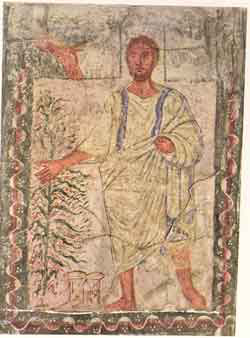The giving of the Law at Sinai, a central event in Israel's history, is described in half a dozen places in the Torah (Exodus 19: 16 - 24; 20: 15 - 18; 24: 1- 18; 34:1-10; 34:27-28; Deuteronomy 5:19 - 28)– each description is a fragment of a bigger puzzle. Even when put together, these fragments do not add up to a unified picture. Perhaps the very nature of the event calls for multiple views: multiple views in the text produce multiple views in art.
In this brief selection of artwork from the 10th through the 20th centuries, we will focus on the treatment of:
- Moses,
- the people,
- the mountain
- the Tablets/Torah.
Our aim is to enable the viewer to experience the continuous involvement of Judaism in the defining moments of Matan Torah and to appreciate how every thinker can access her/his Matan Torah within the variety offered.
Let us start with two relatively recent works that examine the group and the leader.
Moses and the people of Israel
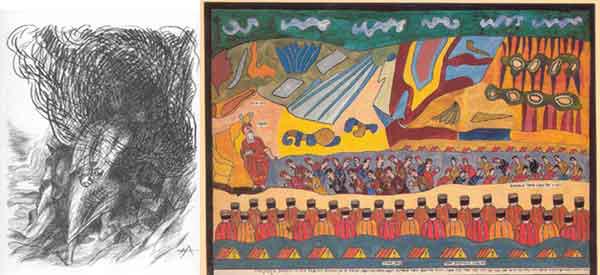
Helmut Ammann, Shalom of Safed, Matan Torah, 1969
Moses schreitet in das Dunkel
(Moses steps into the Dark)
These two extremes may be termed the long shot and the closeup. In one, we focus on Moses, in a decisive moment. In the other, we ourselves are part of the community, their excitement and fear, fervor and trepidation.
Helmut Ammann a twentieth century evangelical German brings us to a mystical interior of Moses based on Exod 20:18 and Exod 24:18 –entirely in shades of black and white. Even without seeing his face we can feel the tension of his posture and movement, clenching his hands behind his back, leaning into the darkness. Imagine your own head where his is and share the anxiety and fervor of his confrontation.
Coming out of his devout Hassidic community Shalom of Safed, a venerable tinker and toy maker, stages a cosmic sound and light show illustrating the synchronous trembling of the people and the mountain in Ex 19:16-18. Rather than focusing on a single individual (even Moses is marginal), his Bible comics invite us to join the congregation.

His page is divided in half and each half into horizontal slices. The upper half brings us into the congregation at Sinai. The lower half takes us to Shalom's Safed to shop in Yiddish before Shavuot, the holiday of Matan Torah, to dine with the family in Hebrew, to daven with the minyan in Aramaic, the languages that fuse the centuries of Ashkenazi Jewish life. The Jews of Safed are the people of Israel at Sinai.
Shalom of Safed's psychedelic collective ecstasy, is a tumultuous contrast to the turbulent though reflective interiority of Helmut Ammann. And both are "true".
The Mountain
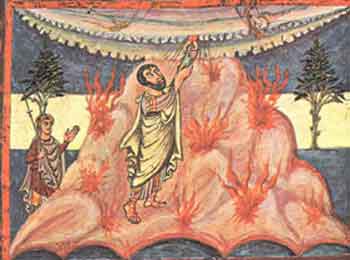

Moving from left to right, these three Mt. Sinai's illustrate a single principle of sacred geography: revelation takes place on a high point to teach us that humanity and God are on a direct vertical line that is called the axis of the world (axis mundi). The mountain (or ladder or tower or ziggurat or stairway) rises; the cloud comes down to meet it, to close the gap between heaven and earth. Wherever this happens, this location marks the movable sacred center. This is where God and humanity meet, this is where the temple is built, this is where the altar is. It's both fixed and portable. Wherever the human being makes the connection, that's where it is.
Note that these three renditions of Matan Torah are completely independent – the shared view comes out of the collective unconscious, not out of an art-historical tradition.
Our fourth component in pictures of Matan Torah is – the Torah!
Torah and Tablets
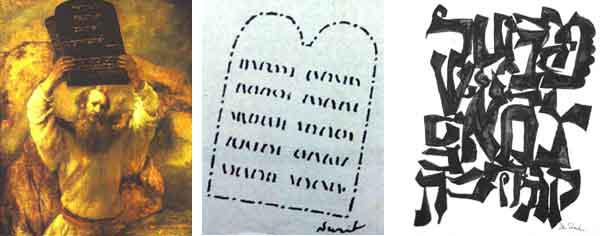
Tablets of the Law, Creation, 1957
1659
Perhaps most familiar to the viewer are realistic tablets with readable letters as in Rembrandt's famous 17th century oil painting, where the anguished Moses is about to smash the tablets. He is, in effect, breaking the covenant with God, tearing up the contract between God and Israel, because of the infidelity of the people around the Golden Calf. Has Rembrandt chosen to expose the second tablet, revealing his own entangled domestic situation?
The other two artists in this trio are moving us away from such familiar figural art. Nurit's cartoon challenges us to decipher seemingly familiar iconography, of the tablets and the writing. But, just as in some dreams, we can't quite make out what it says. She is expressing the uncertainty of the Divine message.
In the third figure, Ben Shahn has eliminated the tablets entirely but not the letters. Influenced by the Sefer Hayetsirah, where the Torah is described as black fire on white fire, he views the alphabet as the tool for Creation whose purpose is Matan Torah. His "Alphabet of Creation" is the scribe setting down letters of the Torah in black ink on white parchment. The amorphous whiteness of an empty page now takes shape around the black letters. Something of God's unknowable whiteness is revealed by setting down the figure against the ground – so the Torah, you may say, is black fire against white fire. The viewer can see the figures of the Hebrew alphabet in black – alternatively, the viewer can focus on the white around the letters, the background to grasp something of the infinity of God
To complete the movement from concrete to abstract, we have two final works.
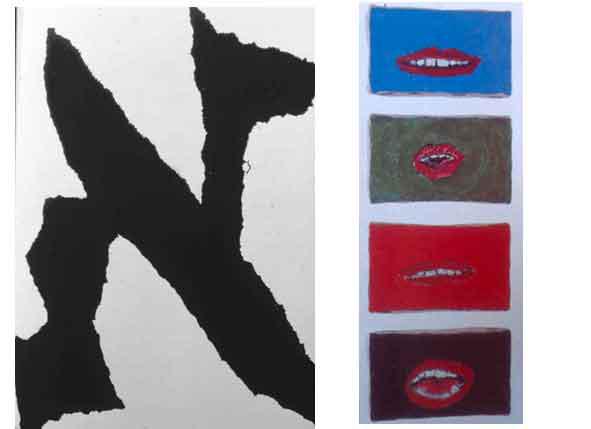
Mark Podwal, Aleph, 1974 Michael Sgan Cohen,
Ye Ho Va Ha,1980
Mark Podwal's Aleph grows out of the mystical tradition that we didn't hear all 10 commandments or even 2; we heard only the first letter (aleph) of the first word (anokhi, I) of the first commandment. (I am the Lord thy God who brought thee out of the land of Egypt…)
How can we hear an aleph? Make your throat as if you're going to pronounce a vowel – there's a closing of the glottis, in preparation for an opening to say the word – that closing, on the verge of opening, is the silent aleph – the potential of everything, but the actuality of nothing.
The intent of this tradition is to stress the utter mystery of the revelation How fitting therefore that the aleph also refers to first three words (names of God) of the first commandment (אnokhi אdonai אlohechem).
Another contemporary artist, Michael Segan-Cohen, also conveys the ineffable silence of Matan Torah (contrast the bedlam of Shalom of Safed) by painting four mouths pursed to form the four letters of the unpronounceable name of God – here the very letters of that name are seen as the essence of the revelation.

In the Birds head Hagaddah, the two tablets, literally given to Moses by the outstretched hand of God, quickly become five—namely the five books of the Torah. Thus we have returned from the mystical plane to the rational earthy concerns of halakha (Jewish law).
This seamless movement from two to five is telling us that for the Jews of medieval Ashkenaz, the 10 commandments are the abbreviated essence of the Torah, the guidelines, which become the books of the Torah.
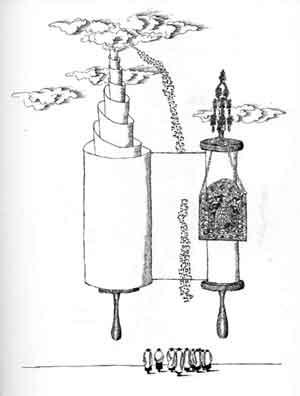
Mark Podwal, Dalet – Derasha, 1978
But the five books are not the end. In this contemporary drawing by Mark Podwal, the letters move through the Torah and beyond: the never-ending road of commentary. Take note that the road is vertical, symbolic of the connection between humanity and God.
And finally, a unique, psychological insight is provided by this illustration from an 13th century illuminated manuscript of Maimonides' Mishneh Torah.
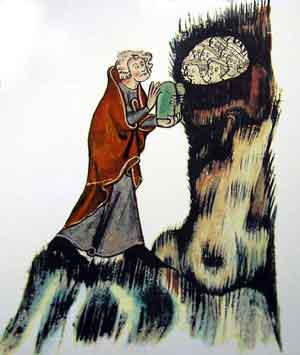
The children of Israel, captive under the glass-like Mt. Sinai, see God through a window which is also a mirror (aspeklaria). Israel sees that God is not only transcendent, but also imminent. Israel grasps that God is also within each of them, (read us) as they accept the Torah from the hands of Moses.
We have selected a lively variety of Torah-giving surprises and questions to talk about for many Shavuot all-nighters. Think about the following questions and others that can serve as the basis for further discussion:
1) How do art and language enable us to communicate with God?
2) What is the relationship between art and the word?
3) How do mystical and rational modes of thought work together?
4) Which of the images comes closest to expressing the ineffable? Explain your choice.
5) How do you personally relate to revelation? Write a poem or create a collage.
6) The giving of Torah is marked by a specific date. Why is there no date in the calendar for receiving the Torah?
7) Comment on Martin Buber's statement that the real miracle of Sinai was synchronicity – nature and the spirit of the people were in synch.
For additional images on this subject see TALI Visual Midrash



